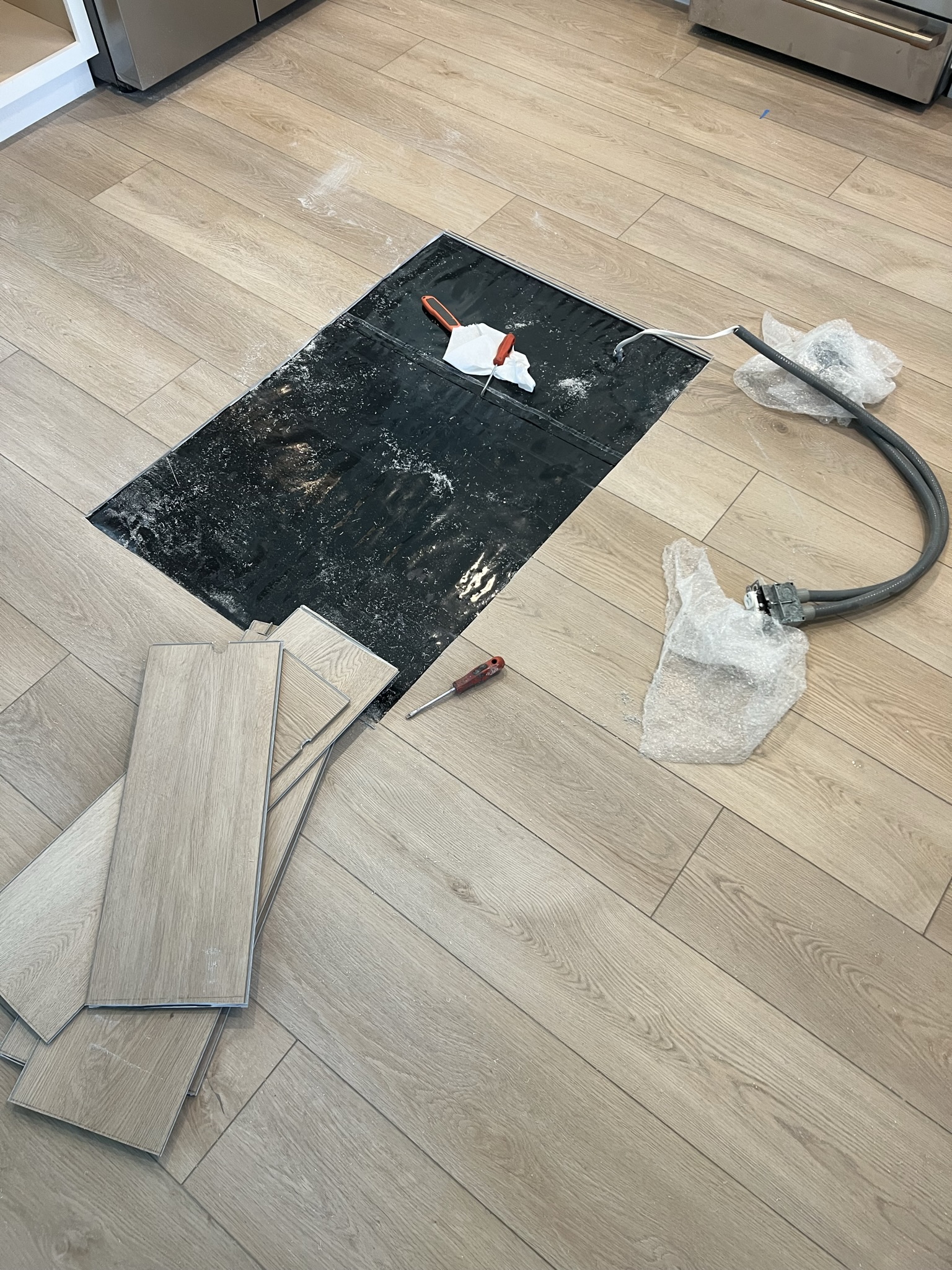Imagine this: you’re finally putting the finishing touches on your dream kitchen. Your countertops gleam, your cabinets are perfectly aligned, and you’ve even picked out your dream appliances. Now there’s just one crucial element left: the kitchen island. You’ve envisioned it as the heart of your kitchen, a place to gather with friends, prepare meals, and even enjoy a quick bite. But as you start planning the layout, a question pops into your mind: can you put a kitchen island on laminate flooring?

Image: domesticblonde.com
The answer, as with many things in home improvement, is: it depends. Laminate flooring is a popular choice for kitchens, offering affordability, durability, and a wide variety of design options. But it also comes with its own set of considerations, particularly when it comes to heavy furniture like a kitchen island. This article will dive into the practical details, addressing common concerns and providing expert advice to help you make the right decision for your kitchen.
Understanding the Challenges of Installing a Kitchen Island on Laminate Flooring
Firstly, it’s important to understand the unique challenges associated with putting a kitchen island on laminate flooring. Unlike hardwood floors, which offer a more solid base and are better equipped to withstand heavy foot traffic, laminate flooring is composed of various layers pressed together, including a core layer, a decorative layer, and a wear layer. This layered structure can make the flooring more susceptible to damage, especially when dealing with the weight of a kitchen island.
The Weight Factor:
Kitchen islands are often substantial pieces of furniture, adding significant weight to your flooring. This weight can lead to a few problems:
- Floor Deflection: The laminate flooring might sag under the weight of the island, creating an uneven surface and potentially damaging the flooring itself.
- Wear and Tear: The constant pressure from the island’s feet can accelerate wear and tear on the laminate, causing scratches, dents, and even delamination.
The Movement Factor:
You’re likely planning to move around your island for cleaning or rearranging, which can also pose challenges:
- Scratches and Dents: Moving the island, especially on a smooth laminate surface, can easily lead to scratches and dents on the floor.
- Damage to the Locking System: Laminate flooring often features a locking system that connects individual planks. Excessive movement can potentially damage this locking mechanism, leading to loose planks and uneven flooring.

Image: diywithchristine.com
Solutions for a Successful Installation
Despite these challenges, you don’t have to abandon your dream of a beautiful kitchen island! With careful planning and the right steps, you can successfully install a kitchen island on laminate flooring. Here’s how:
1. Choosing the Right Laminate:
The first step is to select a laminate flooring that’s designed to withstand heavier loads. Look for:
- High-Density Core: A denser core provides greater stability and reduces the risk of floor deflection.
- Thick Wear Layer: A thicker wear layer offers greater resistance to scratches, dents, and other wear and tear.
- Higher AC Rating: Look for a higher AC (Abrasion Class) rating, which indicates greater resistance to wear and tear.
2. Strengthening the Base:
You can further reinforce your laminate flooring and distribute the island’s weight more evenly by using the following methods:
- Plywood Subfloor: Consider adding a layer of plywood beneath the laminate flooring in the area where the island will be placed. This will create a stronger and more stable base.
- Reinforced Underlayment: Utilizing a thicker and reinforced underlayment beneath the laminate flooring can also provide additional support. This type of underlayment is often designed to cushion high-traffic areas and spread the weight more evenly.
3. Protective Measures:
To minimize potential damage from movement and prevent scratches, take these precautions:
- Protective Pads: Invest in high-quality furniture pads to place under the legs of your kitchen island. These pads should be made of a durable material like felt or rubber to cushion the floor and prevent scratching.
- Heavy-Duty Casters: If you frequently need to move the island, consider incorporating heavy-duty casters designed for smooth and controlled movement. These casters should be able to distribute the weight evenly and minimize friction on the floor.
- Floor Protection Mat: Place a protective floor mat underneath the island to provide an additional buffer between the island and the laminate flooring.
4. Professional Assistance:
If you have any doubts or concerns about the stability of your existing laminate flooring, consult a professional contractor specializing in kitchen renovations. They can assess your specific situation and recommend the best course of action based on your individual needs and preferences.
Maintaining Your Laminate Flooring
Once you’ve taken the necessary steps to prepare your laminate flooring for a kitchen island, it’s crucial to maintain its integrity for years to come.
- Regular Cleaning: Regularly sweep or vacuum your laminate flooring to remove dirt and debris that can cause scratches.
- Avoid Harsh Chemicals: Avoid using harsh chemicals or abrasive cleaners, as these can damage the floor’s finish.
- Protective Mats: Place protective mats in high-traffic areas to minimize wear and tear.
- Prevent Water Damage: Laminate flooring is generally water-resistant but not waterproof. Avoid spills and clean up any accidental drips promptly.
Can You Put A Kitchen Island On Laminate Flooring
The Verdict: Can You Put a Kitchen Island on Laminate Flooring?
The answer is: yes, but with careful planning and preventative measures. By using a high-quality laminate flooring, reinforcing the base, and taking steps to protect the floor from scratches and damage, you can successfully install a kitchen island on laminate flooring and enjoy a beautifully designed and functional kitchen for years to come.






